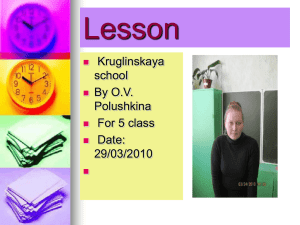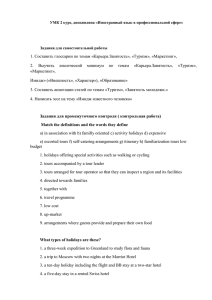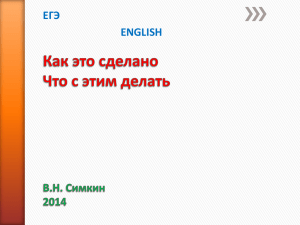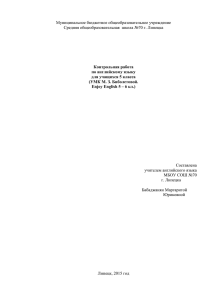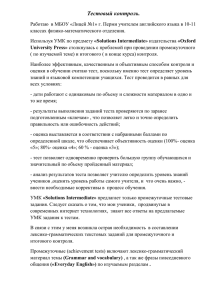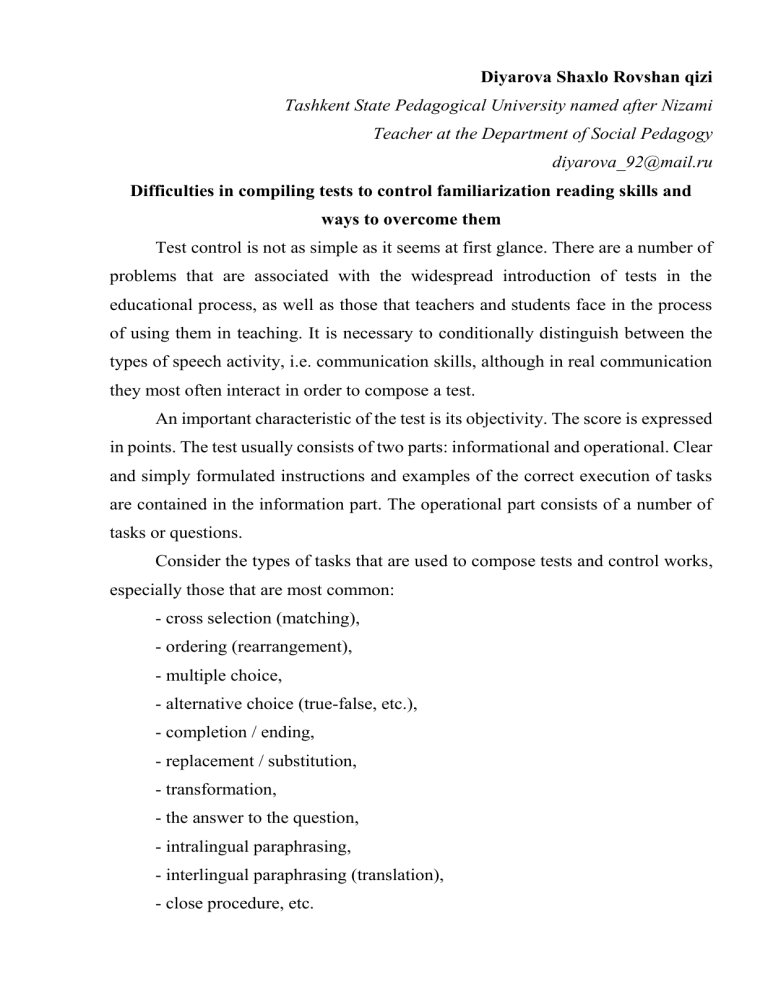
Diyarova Shaxlo Rovshan qizi Tashkent State Pedagogical University named after Nizami Teacher at the Department of Social Pedagogy [email protected] Difficulties in compiling tests to control familiarization reading skills and ways to overcome them Test control is not as simple as it seems at first glance. There are a number of problems that are associated with the widespread introduction of tests in the educational process, as well as those that teachers and students face in the process of using them in teaching. It is necessary to conditionally distinguish between the types of speech activity, i.e. communication skills, although in real communication they most often interact in order to compose a test. An important characteristic of the test is its objectivity. The score is expressed in points. The test usually consists of two parts: informational and operational. Clear and simply formulated instructions and examples of the correct execution of tasks are contained in the information part. The operational part consists of a number of tasks or questions. Consider the types of tasks that are used to compose tests and control works, especially those that are most common: - cross selection (matching), - ordering (rearrangement), - multiple choice, - alternative choice (true-false, etc.), - completion / ending, - replacement / substitution, - transformation, - the answer to the question, - intralingual paraphrasing, - interlingual paraphrasing (translation), - close procedure, etc. To control understanding in the process of reading, it is advisable to use the most adequate selective multiple choice tests in the following varieties: a) choosing the correct answer to the question; b) on the basis of the proposed theses, the completion of the started statement; c) arrangement in order, grouping of facts; d) matching, cross-selection; e) the exclusion of specially inserted superfluous words; e) filling in the gaps with specially omitted words. Test quality indicators are presented to the content of the test, which are also certain requirements. Consistency, or backbone properties of the tasks presented in the test, is one of the important requirements for the content of the test. The system-forming features of the test are that the test tasks belong to one academic discipline. Subject purity of the test, content and structural integrity, i.e. the relationship of test items through a common content (for example, all test items check the level of formation of linguistic competence) and interpretation of the results. The general results of testing are summed up on the basis of an analysis of the performance of individual tasks. Testing time plays an important role and, of course, is the system-forming quality of the test. There is a time limit for running a standardized test, it is usually limited. Time to complete test tasks, according to approximate calculations, is spent: 1 min / task - for reading; 0.8 min/task - for listening; 0.7 min/task - in vocabulary and grammar for tasks with a selective answer. Tasks vary in their degree of difficulty. The test is built as a system of tasks of increasing difficulty. It includes easy tasks that most students should be able to handle (up to 20% of the items on the test), items of medium difficulty (up to 60% of the test items) and difficult tasks that only the most prepared students can handle (up to 20% of the test items). ). The test must contain: • general instructions. The time of the test, the number of tasks, the right to use additional materials are disclosed in this paragraph; • guidelines, instructions for the examiner on the test, on the evaluation of results; • instructions for a specific type of tasks or a group of tasks, united by one basis (text, drawing, etc.) or one task; • actually test tasks; The main requirement of the test preparation methodology is suitability, i.e., compliance with the principles of the adequacy of the test to the nature of the speech activity being tested. When compiling a test, one must take into account the general nature of the text (most often, narrative texts are used, filled with factual material, details that are essential for understanding the text). Test questions should be set out simply for understanding, and that they require one or more answer options. Tests should be such that the student could cope with them. The peculiarity of reading control tests is as follows: 1) Tests help the student to focus on the information they have read. 2) Stimulate mental activity 3) The test serves as an adaptation The complexity of the organizational nature is often the ability to create a favorable psychological environment. It is widely known that the components of a successful test are the benevolence of the teacher and the student's understanding of the task, which would correspond to his age characteristics and interests. In addition, the interpretation of test results should not go beyond the boundaries set by its purpose. Consider the difficulties that arose before us in practice. Stress for the body. Using testing for long periods of time leads to negative health outcomes. To avoid such consequences, you should dose the time of work. A teacher who plans to use testing in his work should explain to students how to avoid overstrain, but at the same time achieve high results when writing tests. Individual characteristics. Everyone's thinking is different. Each student needs his own period of time to understand the content of the test, analyze and choose the correct answer. The pace of reading the text is also different. And therefore reading the text for some students takes a small amount of time, while others take more time. Because of this, not all students can transgress to the text in time, having comprehended the tasks. Some students had trouble understanding the wording of the questions. For this, it is very important for the test compiler to know the requirements when writing tests. Difficulties associated with the content of testing. Testing should take place on the topics covered. Formulation of the question with the correct answer. The content of the task should reflect the content of the training and meet the program requirements. The question contains a complete thought. Wrong answers should be reasonable, skillfully selected, there should be no obvious inaccuracies, hints. When compiling questions, you should be especially careful to use words such as “sometimes”, “often”, “always”, “everything”, “never”. With the main part of the task, all answer options must be grammatically consistent. Use short, simple sentences. Correct and incorrect answers must be unambiguous in content, structure and total number of words. It's always better to use a long question and a short answer. References: 1. Canale V., Swain V. Theoretical bases of communicative approaches to second language teaching and testing// Applied Linguistic – 2010 2. Devies A. The construction of language tests .1997 3. 89.Hughes A. Testing for Language Teachers. Cambridge: Cambridge University Press, 2001. 4. Миролюбова. А.А. Вопросы контроля обученности учащихся ИЯ. Метод. пособие. Под ред.- Обнинск. Титул.2012 5. Нейман Ю. М., Хлебников В. А. Педагогическое тестирование как измерение. Ч.1. — М.: Центр тестирования МО РФ, 2014. 6. Бим И.Л. Об одном их возможных подходов к составлению тестового контроля по ИЯ. 2006 7. Щерба Л.В. Преподавание иностранных языков в средней школе. 2012.

